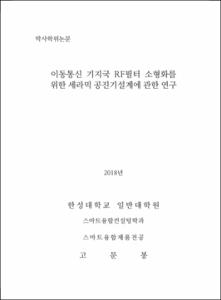이동통신 기지국 RF필터 소형화를 위한 세라믹 공진기설계에 관한 연구
= A Study on the Design of Ceramic Resonator for Miniaturization of RF Filter in Mobile Communication Base Station
- Appears in Collections:
- 스마트융합컨설팅학과 > 1. Thesis
- Files in This Item:
-
-
Download
 200000103541.pdf
기타 데이터 / 3.96 MB / Adobe PDF
200000103541.pdf
기타 데이터 / 3.96 MB / Adobe PDF
-
Items in Repository are protected by copyright, with all rights reserved, unless otherwise indicated.